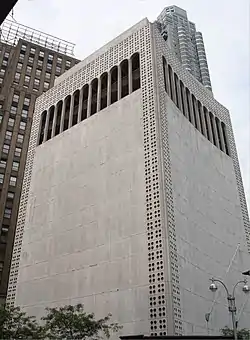Holly Hotchner
Holly Hotchner was the director of the Museum of Arts and Design, or MAD, (formerly the American Craft Museum), in New York City from 1996 to 2013. She was appointed by the museum’s board of governors in 1996. Under her leadership, MAD built a new 58,000-square-foot (5,400 m2) home at 2 Columbus Circle in Manhattan, which opened in September 2008. After 16 years as director, she announced in January 2013 that she would step down at the end of April 2013.[1]
Prior to holding this position, she served as director of the New York Historical Society Museum from 1988-1995. There, her responsibilities included restructuring the administration, overseeing a staff of 40, participating in raising more than $40 million for the institution’s collections, and managing the museum's education programs, general operations, and facilities capital improvement program. From 1984-1988 she was chief conservator at the Historical Society, where she led a new program to enhance the care and cataloguing of the museum’s 1.5 million-object collection.
Before joining the New York Historical Society, Hotchner was a Conservation fellow at the Metropolitan Museum of Art, and also held positions at The Tate Gallery in London, the Hirshhorn Museum in Washington, D.C., the Museum of Modern Art, New York and the Metropolitan Museum of Art in New York.
She holds an M.A. in Art History and a certificate of conservation from the Institute of Fine Arts at New York University, and a B.A. in Art History and Studio Art from Trinity College.
She has served on numerous panels for government funding of the arts, and as a juror for exhibitions and for artists’ awards. She also established Holly Hotchner Fine Arts Management, which provided collections management, cataloguing and conservation services to individuals and corporations.
During her tenure, she has increased the MAD’s operating funds and endowment, while expanding its exhibition programming and outreach. She co-organized a number of critically acclaimed exhibitions at the Museum with accompanying catalogues, including Radical Lace & Subversive Knitting; the series on contemporary Native American art, Changing Hands: Art Without Reservation; Ruth Duckworth: Modernist Sculptor; Corporal Identity–Body Language; Beatrice Wood: A Centennial Tribute; 4 Acts in Glass; Art & Industry: 20th Century Porcelain from Sèvres; Defining Craft I: Collecting for the New Millennium; and Venetian Glass: 20th Century Italian Glass from the Olnick Spanu Collection.
Redesign of 2 Columbus Circle


Under Hotchner's leadership, MAD completed a controversial move to 2 Columbus Circle. The museum's plans to radically alter the building's original design by Edward Durell Stone touched off a preservation battle joined by Tom Wolfe, Chuck Close, Frank Stella, Robert A. M. Stern, Columbia art history department chairman Barry Bergdoll, New York Times' architecture critics Herbert Muschamp and Nicolai Ouroussoff, urbanist scholar Witold Rybczynski, among others. Mayor Michael Bloomberg, The Wall Street Journal critic Ada Louise Huxtable, and others, however, supported the redevelopment of a long neglected site. Stone's son Hicks, also an architect, favored preservation and was appalled that "an institution whose central mission is to preserve cultural artifacts is in fact determined to demolish what is probably its most valuable artifact."
Over time, however, many of Stone's critics became accustomed to the building's unusual appearance and grew to appreciate it.[2] Before the building's alterations, Stone's design at 2 Columbus Circle was listed as one of the World Monuments Fund's "100 Most Endangered Sites for 2006."[3][4] In 2004, the National Trust for Historic Preservation called it one of America's "11 Most Endangered Historic Places."
Pulitzer Prize-winning critic, Justin Davidson, said of the building renovation:
- This version won’t satisfy those who thought it should never have been touched, and it’s not bold enough to overpower their arguments — or, I suspect, to turn the Museum of Arts and Design into an essential destination.[5]
A 2006 article in the New York Times acknowledged that when Holly Hotchner first became director of the institution 10 years earlier, "few people seemed to have heard of it," but then it became arguably best known for "the bitter preservation battle arose over its purchase and planned renovation of 2 Columbus Circle, the 1964 'lollipop' building near Central Park designed by Edward Durell Stone." Ms. Hotchner responded that she hoped it would "become known for what it does, not where it is."[6]
References
- The New York Times: "
- Archinect: "Violations, Grids and Sugarcubes"
- World Monuments Watch: 2 Columbus Circle, World Monuments Fund
- Anderson, Lisa (2005-06-22), 'Cradle of civilization' endangered, fund says., Chicago Tribune
- Davidson, Justin (2008-09-07). "Museum Date". New York Magazine. Retrieved September 8, 2008.
- Pogrebin, Robin (2006-03-22). "The Museum of Arts and Design Prepares for Its New Home". The New York Times. Archived from the original on 2006-04-08. Retrieved 2008-06-17.